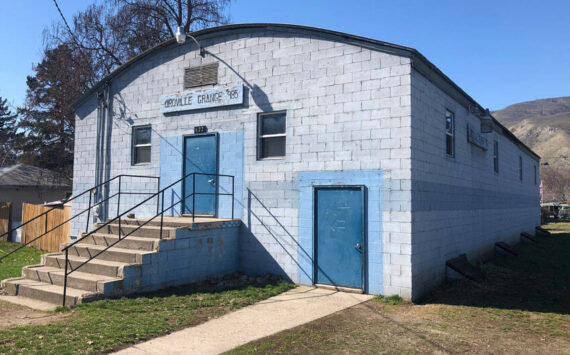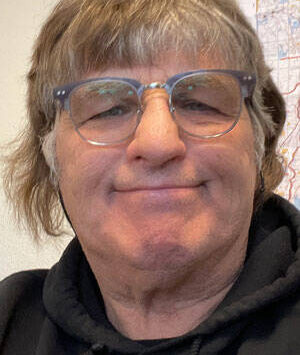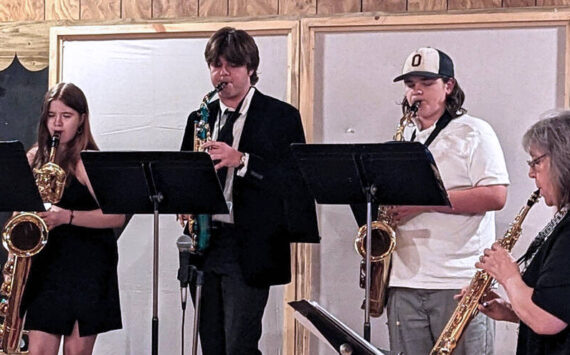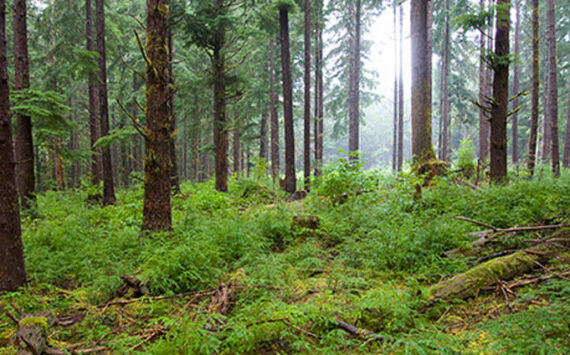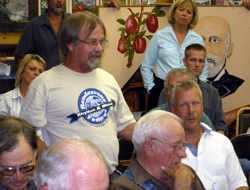

Frank Grunert said he wanted storage at Shanker’s Bend as a way to control a “dangerous” river and to provide irrigation, new energy resources and recreation. He was one of the few voices who spoke out in favor of a dam at Shanker’s bend last Monday night
OROVILLE – More than 120 people packed the Old Oroville Depot to express their concerns over a feasibility study of water storage at Shanker’s bend on the Similkameen River.
The meeting was held by Okanogan County PUD which got a grant from the state Department of Ecology to study the possibility of storing water behind a dam on the Similkameen River. Discussed were dams of three heights, their estimated costs to build, their potential for water storage, electrical power generation and flood control.
If one of the three options were to built it would be located at Shanker’s Bend, about five miles northwest of Oroville and two miles upstream of the PUD’s Enloe Dam Project on the Similkameen River.
Jeremy Pratt, of Entrix, a consultant on the feasibility study, went through the potential benefits and costs of each of the dam height options. The High Dam would have the most far reaching effect, inundating some 1.3 million acre-feet, backing water up all the way into Canada. The Medium Dam would store 138,000 acre-feet and the Low Dam would store 20,000 acre-feet. The High Dam would have the potential to generate 74 megawatts, Medium Dam 23.2 MW and Low Dam, 19.5 MW. As far as flood control the study found the High Dam could greatly control potential floods, the Medium Dam would be significantly less effective and the Low Dam would have little impact on flood control. Estimated costs also varied greatly with the High Dam coming in at $1.02 billion; Medium Dam, $329 million and Low Dam, $289 million.
Dan Boettger, with the Okanogan County PUD, explained that the Okanogan County Commissioners agreed to do the study which was funded by Ecology to be first in line should the project prove to be feasible. He said by doing so it kept the control more local and prevented other entities from out of the area from developing the project. He also introduced the three PUD Commissioners who attended the meeting, Trish Butler, David Womack and Ernie Bolz. State Senator Bob Morton from the Seventh District also attended.
After quickly going over the highlights of the preliminary feasibility study, Pratt opened the meeting up to questions.
Arnie Marchand, a member of the Okanagan Indian Band and the Colville Confederated Tribes, said he recalled a meeting between representatives of the Federal Energy Regulatory Agency and the tribes in Kelowna. He said the Upper and Lower Similkameen Bands, the Confederated Tribes and the Okanogans all had “deep concerns” about any dam at Shanker’s Bend.
“I am not hear to speak for them, but am echoing what they said and they oppose the Shanker’s Bend project,” Marchand said.
George Hanson, vice-chairman of the Regional District of Okanogan-Similkameen in B.C. said he was opposed and had “grave concerns” about the High Dam project backing water into Canada.
“We can not see any detriment in the Medium and Low Dams, we are opposed to you flooding Canada. If the U.S. wants to flood its own land we have no say in that,” he said.
He also said he had concerns about land belonging to the Upper and Lower Similkameen Bands being flooded and about some of the best farm land, a major economic generator in the region, being ruined.
Clint Kendle, who owns property on Palmer Lake, said he was opposed for “obvious reasons.”
He asked the PUD to research whether the numbers in the feasibility study represented actual costs of the land and what it can be sold for.
Mark Kubiac of Oroville, wanted to know the impacts of raising Palmer Lake.
Gene Worthington, who grew up in a house near the Enloe Dam, said she opposed the Shanker’s Bend Dam option and that she believed everyone at Palmer Lake opposed it as well.
Ken Taylor, Vice President of the Okanogan Borderlands Historical Society said as a committee the group had approved the Low Dam while opposing the other options because they would destroy many historical and cultural resources.
“I believe any other level would ruin the historical aspects here… history going back to the 1800s and even before with the First Peoples. I personally oppose all the dams,” Taylor said.
Art Pringle, a vocal voice against a dam at Palmer Lake once proposed by the Oroville-Tonasket Irrigation District years ago, said, “I oppose it period. What I have heard tonight seems to conflict with reports I’ve heard on the Low and Medium Dams as well. If you put in the Medium Dam it looks like it would raise Palmer Lake 30 feet.”
Pratt answered that the High Dam would be at elevation 1289 feet and raise the river 85 feet and the Medium Dam would be at elevation 1175, raising the river 41 feet and the Low Dam would be at 1155 feet and raise the river 21 feet.
Steve Pringle, Art’s nephew, said he lived downstream of Palmer. “It looks like all options would flood me out,” he said, adding “and what about all the Indian Trust Land and all the ranches and how are you going to mitigate the wildlife habitat that will be lost. You will ruin one of the most beautiful valleys in North Central Washington. This is absolute stupidity.”
Iris Nelson said that they needed to talk about people and property as well as the wildlife.
“If you do this I couldn’t give my property away,” she said.
An Osoyoos Town Councilman, Michael Ryan, said the council was very concerned about the dam being located there.
Orchardist Blair Losvar said he couldn’t see any way it would benefit those who lived upstream.
“Who will own the water created by inundating our land?” he asked. “We’re a small operation and we create nearly $1 million annually. Is taking that away going to help Oroville or Tonasket?”
He also asked whether water rights would be granted to people who have already applied for them.
Like many of the questions that night, Pratt answered that he did not know.
“The state owns the water and can grant rights to who it want,” he said.
Boettger said the water created would be part of instream flows and rights to it might not necessarily stay in this area.
“I live in old Richter Pass in Canada and I oppose the dam,” said Sherry Lynn. “If you go to a high dam are you planning on allocating the water stored in Canada? Where are the benefits to the local community,” she asked.
Pratt said he didn’t know the answer and that there was a lot of “international machinery” involved.
“The Canadian values for property have not yet been factored in,” he said.
Rob Mandy said it took him 15 years to find his Nighthawk area land. He said he was not opposed or for the project, but felt valuing the land to be flooded at $100 million was off by a factor of ten.
“The water that comes down the Similkameen doesn’t just stay here, it goes down river. Aren’t we calculating on water already spoken for?” asked Dennis Grimes.
And about the cost of building any of the three dams he said, “I’ve never seen the federal or state government come under budget. And what about the jobs that will be lost locally?”
David Kliegman asked what would happen to mine waste, like that recently moved further up the riverbank at the Kabba Texas Mine site. He also wanted to know whether the PUD planned on using eminent domain to condemn people’s pro
perty or will it actually compensate them with fair market value.
Joseph Enzensberger said he hadn’t heard enough about how they planned to protect a “natural treasure” with a diverse fishery.
“I’m for the fourth option… the no dam option,” he said. “There’s no justification for touching that valley above Enloe. We need to say no to the PUD and to the other PUDs, we have to preserve this place.”
Dixon Terbasket, with the Lower Similkameen Band, said white settlers had already taken more than 90 percent of his ancestors’ land and now they want to flood what’s left of it.
“You want to sell my water, who the hell gives you that right?”
For more details on the feasibility study and more comments from the meeting see next week’s Gazette-Tribune.

